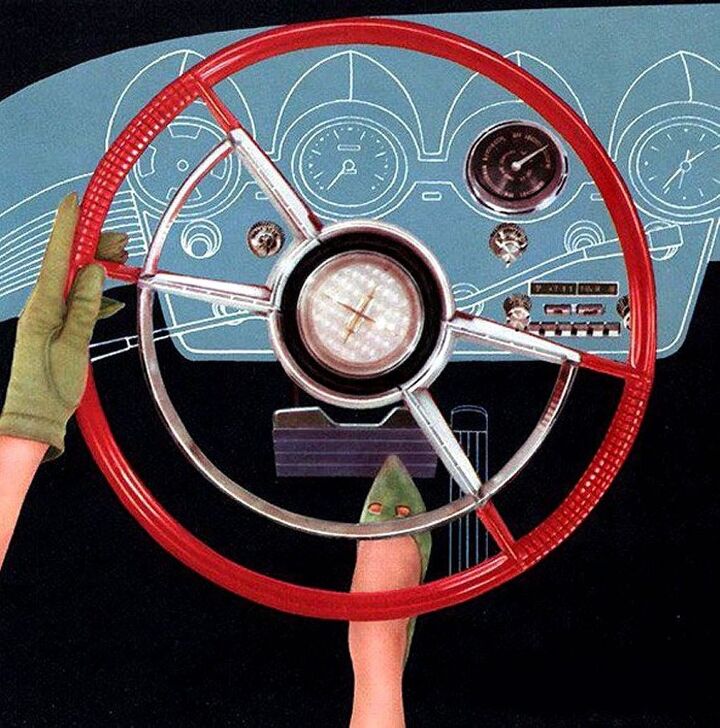Rare Rides Icons: The Lincoln Mark Series Cars, Feeling Continental (Part X)

We resume our tale of the Mark series cars today, during a period of recovery for Lincoln and their Continental lineup. The introduction of all-new unibody Lincolns in 1958 saw questionable over-the-top styling debut right at the start of a sharp recession. Most people didn't enjoy the looks of the new Mark III. Lincoln toned down the glitz for the '59 models, with better-integrated styling cues here, and less bulbous sheet metal there.
A new naming scheme arrived in 1959, Mark IV Continental, as Continental became a version of Mark. At the same time, Ford attempted to take the Continental upscale via the introduction of the more spacious (but not longer outside) Mark IV Continental Town Car and Limousine.
With a better US economy, Lincoln improved its sales figures considerably in 1959. However, the portion of those sales that were Continental models dropped by almost 12 percent. However, given all the millions Ford poured into its new Lincoln models it was not prepared to ditch them after just two years. There was a third year of the unibody Mark, with the highest series number yet: V.
Given the general criticism of Lincoln's styling over the prior two years and that the 1960s were nearly a mechanical carry-over, the Mark V Continental needed some new, stand-out styling to bring customers into the showroom. There had been a bit of reorganization in Lincoln's design department for each model year of this generation. The Mark III for '58 was penned by John Najjar with assistance of future design star Elwood Engel. Engel was responsible in the interim for toning the Continentals down in 1959. New face Don Delarossa managed the 1960s as the replacement for Najjar as Lincoln’s lead stylist.
At the front of the Mark V Continental, the Dagmars of 1958 that disappeared in 1959 returned in full force for 1960. They poked out from a new bumper design that was lower to the ground than either of the prior front end designs.
With chrome nearer to the ground, the front of the Mark V looked more planted than previous iterations. The jet or rocket indicator housings at the corners of the bumper disappeared, and were replaced by simple rectangular indicators at the corner of the bumper. The bumper's shape was simpler than it was before, and lost the cut-out ridge that ran along its upper edge. Said upper edge was removed entirely, as the bumper shrunk away from the grille.
By necessity, the grille grew larger on the Mark V to take up the extra space, and had a new pattern. Rather than the simple Mark IV eggcrate, the Mark V had larger segments with small diamond-like decorations within each. The look was not entirely removed from the hated Fashion-Aire Dynastar grille from 1958 Buicks.
The hood above the flashy new grille grew some new bulges, spaced apart across the metal and totaling three in number. The 1960's bulges were more defined than the previous year, and ran all the way to the windshield. Canted headlamps remained in place for 1960, and were still surrounded by the grille as they were in 1959.
Chrome along the hood line wrapped around the lamps the same as it did before. At the front corners, the space where the rocket decorations existed previously was occupied by the simple wrap-around of the chrome bumper, and unadorned fender. Said fenders had the same revised detailing in the metal behind the front wheel, carried over from '59. Above, there was a new take on the Continental script which lost its long T stroke, and looked a bit lighter.
Behind the front wheel, festoonery increased via four new chrome spears. The spears took the place of the Mark IV block lettering of the prior year. Buyers would notice a new smooth dog dish wheel cover design, which had smaller outside veins that were much less visible. The Mark III and IV both used almost identical wheel covers to the hand-assembled Mark II.
Along the side of the Mark V, body edits ahead of the C-pillar were almost non-existent, but that changed as the eye reached the rear fins. The leading edge of either fin was extended further to the rear for 1960 for a more dramatic appearance. Both fins were capped in a new chrome trim piece, which continued in a spear that intruded into the rear fascia. Below the new fin extension was a more defined character line, which ended in another new piece of chrome that was sort of parenthesis-shaped.
Just before that new piece of chrome was a new take on the Mark series badge, with MARK V spelled out in gold block lettering, a golden line struck right through the middle of every letter. This badge was not present in prior years where the rear fender went without branding. Underneath it, the fender’s shape and corners of the bumper remained the same as they were the prior year.
From a rear view, the Mark V was much busier than the Mark IV. The new fin intrusion and extra chrome attachments edited the rounded look of the Mark IV into something much more square. Rather than a convex rear fascia, the grille decoration was now almost flat, though indented slightly to a V in the middle.
Rear lamps were pushed toward the middle of the rear by the new fin décor, and were of a new style: Six circular lights replaced the ovals of 1959. The lenses protruded like big red panic buttons, and were more noticeable than the Mark IV. Though the corners of the bumper looked the same as the past Mark, the metal between did not. The bumper received a sharp lower edge, which made the chrome more noticeable. At the trunk lid, the edge design was repeated. The 1960 Continentals had more rear brightwork than either the '59 or '58s.
The Mark V fared better on its interior rework, with a new dash layout that would last only one year. Gauges were reworked entirely and stepped away from the previous single pod layout where all gauges were flat, and covered by one piece of glass. In their place were four circular dials housed in their own hooded binnacles.
The look was not far from what Mercedes-Benz offered at the time. Under the four pods with fuel and temperature, speed, climate control detail, and the clock were the radio controls, and buttons for the wipers and lights. The overall interior design was a bit sportier and looked more upscale than the '59. But exterior and interior changes were not the only alterations Lincoln made to the Continental for 1960, a few things changed on the mechanical front too.
There was also a revision in the lineup at Lincoln: Ford’s luxury arm switched things up to salvage one final year out of its unibodies, and compete better with revised offerings from General Motors and Chrysler. We’ll pick up there next time and cover pricing and sales figures, as 1960 proved to be a last-of moment for the Mark cars.
[Images: Ford]
Become a TTAC insider. Get the latest news, features, TTAC takes, and everything else that gets to the truth about cars first by subscribing to our newsletter.

Interested in lots of cars and their various historical contexts. Started writing articles for TTAC in late 2016, when my first posts were QOTDs. From there I started a few new series like Rare Rides, Buy/Drive/Burn, Abandoned History, and most recently Rare Rides Icons. Operating from a home base in Cincinnati, Ohio, a relative auto journalist dead zone. Many of my articles are prompted by something I'll see on social media that sparks my interest and causes me to research. Finding articles and information from the early days of the internet and beyond that covers the little details lost to time: trim packages, color and wheel choices, interior fabrics. Beyond those, I'm fascinated by automotive industry experiments, both failures and successes. Lately I've taken an interest in AI, and generating "what if" type images for car models long dead. Reincarnating a modern Toyota Paseo, Lincoln Mark IX, or Isuzu Trooper through a text prompt is fun. Fun to post them on Twitter too, and watch people overreact. To that end, the social media I use most is Twitter, @CoreyLewis86. I also contribute pieces for Forbes Wheels and Forbes Home.
More by Corey Lewis
Latest Car Reviews
Read moreLatest Product Reviews
Read moreRecent Comments
- Teddyc73 Oh look dull grey with black wheels. How original.
- Teddyc73 "Matte paint looks good on this car." No it doesn't. It doesn't look good on any car. From the Nissan Versa I rented all the up to this monstrosity. This paint trend needs to die before out roads are awash with grey vehicles with black wheels. Why are people such lemmings lacking in individuality? Come on people, embrace color.
- Flashindapan Will I miss the Malibu, no. Will I miss one less midsize sedan that’s comfortable, reliable and reasonably priced, yes.
- Theflyersfan I used to love the 7-series. One of those aspirational luxury cars. And then I parked right next to one of the new ones just over the weekend. And that love went away. Honestly, if this is what the Chinese market thinks is luxury, let them have it. Because, and I'll be reserved here, this is one butt-ugly, mutha f'n, unholy trainwreck of a design. There has to be an excellent car under all of the grotesque and overdone bodywork. What were they thinking? Luxury is a feeling. It's the soft leather seats. It's the solid door thunk. It's groundbreaking engineering (that hopefully holds up.) It's a presence that oozes "I have arrived," not screaming "LOOK AT ME EVERYONE!!!" The latter is the yahoo who just won $1,000,000 off of a scratch-off and blows it on extra chrome and a dozen light bars on a new F150. It isn't six feet of screens, a dozen suspension settings that don't feel right, and no steering feel. It also isn't a design that is going to be so dated looking in five years that no one is going to want to touch it. Didn't BMW learn anything from the Bangle-butt backlash of 2002?
- Theflyersfan Honda, Toyota, Nissan, Hyundai, and Kia still don't seem to have a problem moving sedans off of the lot. I also see more than a few new 3-series, C-classes and A4s as well showing the Germans can sell the expensive ones. Sales might be down compared to 10-15 years ago, but hundreds of thousands of sales in the US alone isn't anything to sneeze at. What we've had is the thinning of the herd. The crap sedans have exited stage left. And GM has let the Malibu sit and rot on the vine for so long that this was bound to happen. And it bears repeating - auto trends go in cycles. Many times the cars purchased by the next generation aren't the ones their parents and grandparents bought. Who's to say that in 10 years, CUVs are going to be seen at that generation's minivans and no one wants to touch them? The Japanese and Koreans will welcome those buyers back to their full lineups while GM, Ford, and whatever remains of what was Chrysler/Dodge will be back in front of Congress pleading poverty.





































Comments
Join the conversation
"Canted" quad headlights were such a fleeting style... they went away quickly and never came back.
This Continental series and (the Imperial series before it) have been some of my favourite histories on TTAC. I wait for each article with bated breath. Great work!